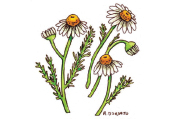Integrative Oncology is guest edited by Barrie R. Cassileth, MS, PhD, of Memorial Sloan Kettering Cancer Center, New York.
The use of dietary supplements by patients with cancer has increased significantly over the past 20 years despite insufficient evidence of safety and effectiveness. Finding reliable sources of information about dietary supplements can be daunting. Patients typically rely on family, friends, and the Internet, often receiving misleading information.
The ASCO Post’s Integrative Oncology series is intended to facilitate the availability of evidence-based information on integrative and complementary therapies commonly used by patients with cancer. We chose chamomile for this issue because of its widespread use as a calming herb.
Compiled by Barrie R. Cassileth, PhD, and Jyothirmai Gubili, MS, of Memorial Sloan Kettering Cancer Center. The free About Herbs website is managed by K. Simon Yeung, PharmD, MBA, Lac, of Memorial Sloan Kettering Cancer Center.
Scientific Name: Matricaria recutita, Chamomilla recutita, Matricaria chamomilla
Common Names: Hungarian chamomile, wild chamomile
Overview
An aromatic annual herb prevalent in Europe, North Africa, and Northwest Asia, chamomile has been used as a medicinal plant for several centuries. It has been used to treat stomach and menstrual disorders, insomnia, rheumatic pain, and hemorrhoids.
Today, chamomile-derived essential oils are used in cosmetics and aromatherapy. Chamomile tea, which is brewed from the dried flower heads, has gained worldwide popularity as a sleep aid and for its calming effects. Current data indicate chamomile’s effectiveness against generalized anxiety disorder and insomnia. It also has wound-healing properties and is being considered as a treatment for mucositis associated with chemotherapy.
Chamomile is available online and in health food stores in the form of tablets, capsules, liquid extracts, oil, tea, tinctures, and in ointments for topical use.
The Science
Chamomile extracts have demonstrated anti-inflammatory,1 antihyperglycemic,2 antigenotoxic,3 wound healing,4 and anticancer5 effects in vitro and in animal models. Terpenoids and flavonoids, present in the dried flowers, contribute to the herb’s medicinal effects.
Proposed mechanisms of chamomile’s anti-inflammatory activity involves inhibition of COX-2 (cyclooxygenase 2) enzyme, resulting in release of lipopolysaccharide-induced prostaglandin E2 in RAW 264.7 macrophages.1 Apigenin, a flavone present in chamomile, exerts strong chemopreventive effects,6 and was shown to inhibit the progression and metastasis of choriocarcinoma cells by regulating the phosphatidylinositol 3-kinase/protein kinase B (PI3K/AKT) and extracellular signal-regulated kinase/mitogen-activated protein kinase (ERK1/2 MAPK) pathways.7 Also, concurrent use of bisabolol oxide A, another constituent, decreased the dose of fluorouracil (5-FU) needed to inhibit the growth of human leukemia cells.8

Jyothirmai Gubili, MS
Preliminary data from clinical studies suggest modest benefits of chamomile, taken orally, in improving chronic insomnia.9 Oral intake of a chamomile extract was also shown to have a mild-to-moderate effect in patients with generalized anxiety disorder.10 The precise mechanisms underlying the anxiolytic effects of chamomile have yet to be determined.
Chamomile’s wound-healing property has been explored in a few studies as well. Application of a chamomile compress was shown to be effective—and superior to hydrocortisone ointment—in facilitating healing of peristomal skin lesions in patients following colostomy,11 but trials involving a mouthwash containing chamomile for ameliorating 5-FU–induced mucositis produced conflicting results.12-14
A recent observational study reported that consumption of chamomile tea was associated with a decreased risk of thyroid cancer.15 Additional research is needed to determine the anticancer potential of chamomile.
Adverse Reactions
Hypersensitivity reactions, including asthma, contact dermatitis, and anaphylaxis, can occur following exposure to chamomile.16-18
Case Reports
Premature constriction of fetal ductus arteriosus after consumption of chamomile tea by a mother during pregnancy19
Severe anaphylaxis with generalized urticaria, angioedema, and severe dyspnea in a 38-year-old man 1 hour after consuming chamomile tea; symptoms improved following treatment with an intravenous antihistamine20
Multiple internal hemorrhages in a 70-year-old woman after concurrent use of chamomile products and warfarin21
Occupational allergic rhinoconjunctivitis from the inhalation of dried chamomile flowers22
Herb-Drug Interactions
Anticoagulants/antiplatelets: Chamomile may have additive effects. Because of its coumarin content, it may inhibit platelet activity.21
Cytochrome P450 substrates: Chamomile has been shown to inhibit CYP1A2, CYP2C9, CYP2D6, and CYP3A4 and may increase the intracellular concentration of drugs metabolized by these enzymes. The clinical relevance is yet to be determined.23
Cyclosporine: Concurrent use of cyclosporine and chamomile resulted in increased serum levels of cyclosporine.24 ■
Disclosure: Ms. Gubili reported no potential conflicts of interest.
References
1. Srivastava JK, Pandey M, Gupta S: Chamomile, a novel and selective COX-2 inhibitor with anti-inflammatory activity. Life Sci 85:663-669, 2009.
2. Cemek M, Kaga S, Simsek N, et al: Antihyperglycemic and antioxidative potential of Matricaria chamomilla L. in streptozotocin-induced diabetic rats. J Nat Med 62:284-293, 2008.
3. Hernández-Ceruelos A, Madrigal-Bujaidar E, de la Cruz C: Inhibitory effect of chamomile essential oil on the sister chromatid exchanges induced by daunorubicin and methyl methanesulfonate in mouse bone marrow. Toxicol Lett 135:103-110, 2002.
4. Reddy KK, Grossman L, Rogers GS: Common complementary and alternative therapies with potential use in dermatologic surgery. J Am Acad Dermatol 68:e127-e135, 2013.
5. Srivastava JK, Gupta S: Antiproliferative and apoptotic effects of chamomile extract in various human cancer cells. J Agric Food Chem 55:9470-9478, 2007.
6. Patel D, Shukla S, Gupta S: Apigenin and cancer chemoprevention. Int J Oncol 30:233-245, 2007.
7. Lim W, Park S, Bazer FW, Song G: Apigenin reduces survival of choriocarcinoma cells by inducing apoptosis via the PI3K/AKT and ERK1/2 MAPK pathways. J Cell Physiol. March 11, 2016 (early release online).
8. Ogata-Ikeda I, Seo H, Kawanai T, et al: Cytotoxic action of bisabololoxide A of German chamomile on human leukemia K562 cells in combination with 5-fluorouracil. Phytomedicine 18:362-365, 2011.
9. Zick SM, Wright BD, Sen A, Arnedt JT: Preliminary examination of the efficacy and safety of a standardized chamomile extract for chronic primary insomnia. BMC Complement Altern Med 11:78, 2011.
10. Amsterdam JD, Li Y, Soeller I, et al: A randomized, double-blind, placebo-controlled trial of oral Matricaria recutita (chamomile) extract therapy for generalized anxiety disorder. J Clin Psychopharmacol 29:378-382, 2009.
11. Charousaei F, Dabirian A, Mojab F: Using chamomile solution or a 1% topical hydrocortisone ointment in the management of peristomal skin lesions in colostomy patients. Ostomy Wound Manage 57:28-36, 2011.
12. Fidler P, Loprinzi CL, O’Fallon JR, et al: Prospective evaluation of a chamomile mouthwash for prevention of 5-FU-induced oral mucositis. Cancer 77:522-525, 1996.
13. Carl W, Emrich LS: Management of oral mucositis during local radiation and systemic chemotherapy. J Prosthet Dent 66:361-369, 1991.
14. Dos Reis PE, Ciol MA, de Melo NS, et al: Chamomile infusion cryotherapy to prevent oral mucositis induced by chemotherapy. Support Care Cancer. May 17, 2016 (early release online).
15. Riza E, Linos A, Petralias A, et al: The effect of Greek herbal tea consumption on thyroid cancer. Eur J Public Health 25:1001-1005, 2015.
16. Vandenplas O, Pirson F, D’Alpaos V, et al: Occupational asthma caused by chamomile. Allergy 63:1090-1092, 2008.
17. Jacob SE, Hsu JW: Reactions to Aquaphor. Pediatr Dermatol 27:103-104, 2010.
18. Anzai A, Vázquez Herrera NE, Tosti A: Airborne allergic contact dermatitis caused by chamomile tea. Contact Dermatitis 72:254-255, 2015.
19. Sridharan S, Archer N, Manning N: Premature constriction of the fetal ductus arteriosus following the maternal consumption of camomile herbal tea. Ultrasound Obstet Gynecol 34:358-359, 2009.
20. Andres C, Chen WC, Ollert M, et al: Anaphylactic reaction to camomile tea. Allergol Int 58:135-136, 2009.
21. Segal R, Pilote L: Warfarin interaction with Matricaria chamomilla. CMAJ 174:1281-1282, 2006.
22. Benito P, Rodríguez-Perez R, García F, et al: Occupational allergic rhinoconjunctivitis induced by Matricaria chamomilla with tolerance of chamomile tea. J Investig Allergol Clin Immunol 24:369-370, 2014.
23. Ganzera M, Schneider P, Stuppner H: Inhibitory effects of the essential oil of chamomile and its major constituents on human cytochrome P450 enzymes. Life Sci 78:856-861, 2006.
24. Colombo D, Lunardon L, Bellia G: Cyclosporine and herbal supplement interactions. J Toxicol 2014:145325, 2014.



